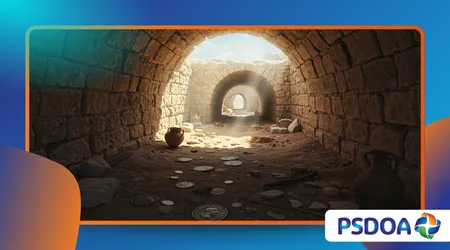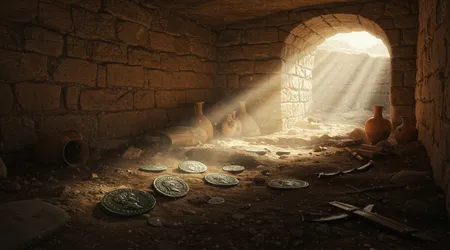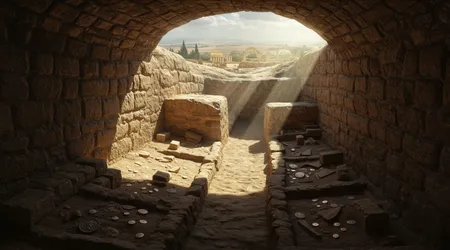Unearthing the Gallus Revolt: Coins and Tunnels of Resistance in Roman Galilee

From the moment we break ground in Galilee, the story of Unearthing the Gallus Revolt beckons us. This phrase is our thread through tunnels, coins, and suppressed memories from 4th-century Judea under Roman rule.
Anúncios
Recent discoveries in the archaeological site of Hukok (Lower Galilee) have brought to light a hoard of 22 copper coins dated to the mid-4th century CE, bearing the images of Emperors Constantius II and Constans I hidden deep within a subterranean complex. (Live Science)
These finds raise profound questions: how did local Jewish communities in Galilee respond to Roman dominion? How did they repurpose ancient tunnels, and what might the hidden coins reveal about resistance strategies?
In this article, we delve into how Unearthing the Gallus Revolt reshapes our understanding of underground defiance, communal memory, and daily survival.
The Historical Context: Revolt in the Shadow of Empire
In 351–352 CE, during a period of Roman civil strife, Jewish communities in Syria Palaestina rose against the authority of the Caesar Gallus (Constantius Gallus).
Anúncios
This uprising is sparsely recorded; the scant textual sources (such as Sozomen, Socrates, and later chroniclers) give only brief mention of the “Jewish revolt against Constantius Gallus.” (Wikipedia)
According to historical reconstructions, the revolt was led by Isaac of Sepphoris (aka Isaac of Diocaesarea), possibly aided by a figure called Patricius or Natrona, with focal points in the Galilee region (Sepphoris, Diocaesarea) and nearby towns. (Wikipedia)
++ Forgotten Maritime Empires of the Ancient World
Roman sources claim a harsh suppression: Gallus’s general Ursicinus led forces that crushed the revolt, destroyed Jewish towns, and reasserted imperial control. Casualty figures are vague, but several thousand Jewish rebels were likely killed. (Wikipedia)
Given the sparsity of direct evidence, Unearthing the Gallus Revolt has long been a challenge for historians and archaeologists alike.

The Tunnels of Galilean Hiding Complexes
Beneath Galilean settlements like Hukok lie networks of tunnels, chambers, and subterranean hideaways carved over centuries.
These complexes likely originated during the First Jewish–Roman War (66–70 CE) and were expanded during the Bar Kokhba revolt (132–136 CE). (Archaeology Magazine)
What’s remarkable is that these same tunnels now appear to have been reused during the mid-4th century crisis.
Also read: Mysterious Historical Artifacts That Defy Explanation
The newly discovered coin hoard suggests that local Jews turned to inherited subterranean refuges to stash valuables, hide, and resist oversight a vivid manifestation of Unearthing the Gallus Revolt in physical form. (Live Science)
These hideouts were narrow, maze-like, often with dead ends and tight passages unsuitable for Roman soldiers in full armor but ideal for furtive retreat and storage. (Reuters)
Archaeologists believe residents may have retreated with essential goods into these tunnels under siege, leaving behind goods they hoped to reclaim later though many never did. Unearthing the Gallus Revolt thus links material culture and lived desperation.
Coins as Witnesses: The Hoard at Hukok
The 22 copper coins found in Hukok bear portraits of Constantius II and Constans I, anchoring their minting in the era spanning the revolt. (Live Science)
Since the coins date to about 351–352 CE, their deliberate concealment suggests a reaction during or just before the uprising thus they are tangible relics of Unearthing the Gallus Revolt. (Archaeology Magazine)
This find echoes a prior hoard in Lod, where archaeologists uncovered 94 Roman and bronze coins beneath a building floor, some minted up to 354 CE. That earlier stash is also tied to responses around the Gallus Revolt. (Smithsonian Magazine)
Read more: The Secret History of the Vatican Archives
Because written sources lack detailed economic data on the revolt, numismatic evidence becomes vital. Coins speak of circulation, hoarding behavior, and trust (or lack thereof) in public institutions.
Table: Key Data of Tunnel Finds and Coin Hoards
| Site / Location | Coins Found & Dating | Tunnel / Hiding Complex Characteristics | Implications for Unearthing the Gallus Revolt |
|---|---|---|---|
| Hukok, Galilee | 22 copper coins (Constantius II & Constans I) | Narrow winding tunnel, crevice pit, reused older network | Direct physical tie to Jewish reaction during revolt (Live Science) |
| Lod, Israel | 94 bronze & Roman coins (up to 354 CE) | Beneath public building, no deep chambers | Suggests emergency stash during Gallus era (Biblical Archaeology Society) |
| Other Galilee tunnels | — | Tunnels first carved in earlier revolts | Demonstrates reuse over centuries (Archaeology Magazine) |
This data underscores how material fragments add texture to the otherwise thin record of the 4th-century revolt.
Digging into Meaning: Strategies of Resistance
When we talk about Unearthing the Gallus Revolt, it’s not just about artifacts: it’s about strategy. Hiding coins deep underground is an act of hope and resistance. It suggests that people expected to return, recover, and rebuild.
Local Jews in Galilee may have anticipated Roman suppression, but still preserved belief in communal survival. In effect, these subterranean hoards turned into a kind of insurance policy an underground safety deposit box.
Moreover, the reuse of older tunnels shows continuity. The same subterranean infrastructure built in earlier revolts was recycled for mid-century defiance. That continuity reinforces the symbolic nature of Unearthing the Gallus Revolt as part of a longer tradition of resistance.
Example 1: The Widow’s Hoard
Imagine a small household in Galilee during 352 CE. As Roman troops approach, a widow gathers what she can: a few small coins, religious objects.
She descends with relatives into a family tunnel, deposits her small hoard into a niche, then emerges later if surviving. That niche might now be the 22-coin find in Hukok.
That narrative demonstrates how Unearthing the Gallus Revolt is more than grand names it’s about everyday courage.
Example 2: The Rabbi’s Concealed Legacy
Suppose a rabbinical school based in a Galilean town senses increased Roman scrutiny. Teachers and students bury their manuscripts, monetary gifts, and ritual items deep in a tunnel network.
They hope to preserve Jewish learning even if their physical building is destroyed. The coins found may be part of such caches. In that scenario, Unearthing the Gallus Revolt reveals not just resistance, but cultural preservation.
Broader Implications: Memory, Archaeology, and Identity
The discovery renews interest in how Jewish communities under Roman rule chose to remember or to conceal their struggles. Unearthing the Gallus Revolt helps fill a historiographical gap, offering material proof where textual sources are silent.
It also raises questions of identity: were those hiding coins also hiding rituals, texts, and community networks? Might further excavations reveal portable ritual artifacts, scroll fragments, or symbolic objects?
From the vantage of 2025, archaeologists and numismatists see this as a flagship moment of rediscovery of ignored heritage. Already the site at Hukok is being prepared for public visitation, connecting modern identities to hidden rebellion. (Archaeology Magazine)
Analogy: Archaeology as Time-locked Safe

Think of the tunnels and coin hoards as a time-locked safe. The builders intended these vaults to remain sealed until a safer era.
Opening them centuries later retrieving coins, reading tunnels is like cracking a safe designed by ancestors, only activated now. In that sense, Unearthing the Gallus Revolt is unlocking an archive built underground.
Challenges & Open Questions
- Why did the revolt fail so swiftly? Roman records claim a brutal suppression, but details remain obscured.
- Did entire communities escape into tunnels, or only elites and families with resources?
- What else lies hidden beyond small coin deposits ritual objects, manuscripts, personal items?
- How did regional geology influence where hiding complexes were built?
Continued excavation, remote sensing, and conservation efforts will be critical to deepen Unearthing the Gallus Revolt beyond these first tantalizing finds.
Next Horizons: What to Watch
- Publication of full numismatic study of Hukok hoard (e.g. Israel Numismatic Research)
- Comparative analysis with coin finds from Lod and other sites tied to the revolt (Biblical Archaeology Society)
- Ground-penetrating radar surveys across Galilean settlements to locate more hiding complexes
- Interdisciplinary work linking archaeology, ancient texts, and Jewish memory traditions
Each of these steps will expand the reach of Unearthing the Gallus Revolt from coins and tunnels to social history.
Conclusion
The act of Unearthing the Gallus Revolt is a reclamation of a hidden struggle, preserved beneath the soil of Galilee.
The 22 coins from Hukok reanimate voices long silenced, while tunnels speak of covert resistance and communal resolve. These discoveries fill gaps in a revolt often dismissed as marginal.
They remind us that beneath every ancient settlement, lives and legacies linger. That even in subjugation, human communities carve refuges literal and metaphorical to survive and remember.
Will future digs unearth a hidden scroll, a devotional object, or a larger condemnation? Only time, and steady archaeology, will show.
What was once forgotten may now guide us to reimagine resilience in a suppressed past.
Duvidas Frequentes (FAQ)
Q1: How certain is the dating of the coin hoard to the Gallus Revolt?
A: Very plausible. The coins bear portraits of Constantius II and Constans I, corresponding exactly with the 4th-century timeframe of the revolt. (Live Science)
Q2: Could the tunnels have been used for other purposes, not revolt?
A: Yes. Many were originally built for refuge during earlier revolts (Great Revolt, Bar Kokhba). Their reuse in 4th century suggests layered functionality. (Archaeology Magazine)
Q3: What other sites have yielded Gallus-era coin finds?
A: Lod is a key example: archaeologists there discovered 94 coins beneath a public building, some dating to the Gallus period. (Biblical Archaeology Society)
Q4: Will the public be able to visit Hukok’s tunnels?
A: Plans are underway to open the site for archaeological tourism, with interpretive exhibits linking the tunnels and coins to Jewish heritage. (Archaeology Magazine)
Q5: Why was the revolt suppressed so harshly and quickly?
A: Likely due to Roman military strength, internal divisions, and limited coordination among Jewish communities. Ancient sources note destruction of towns and punitive reprisals. (Wikipedia)
